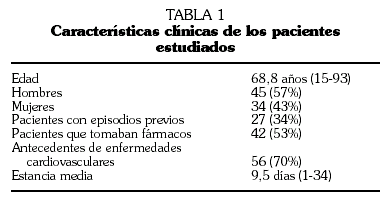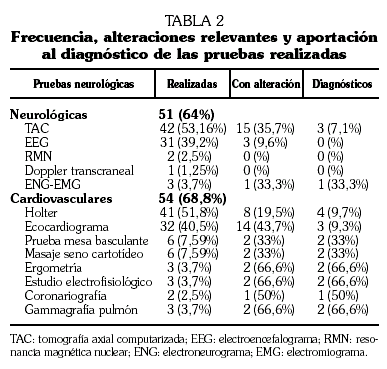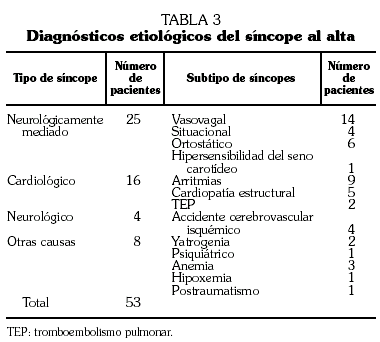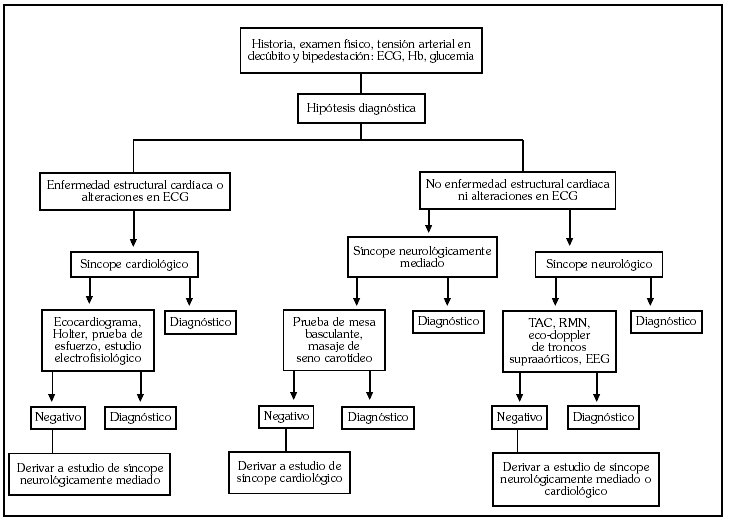Introducción. El síncope es una patología frecuente, en ocasiones de difícil diagnóstico, de modo que un importante porcentaje queda sin filiar tras realizar pruebas diagnósticas, a veces innecesarias. Método. Se realiza un análisis retrospectivo de los pacientes ingresados por síncope en un servicio de Medicina Interna del Hospital Clínico Universitario de Zaragoza durante dos años. Resultados. De un total de 2.878 pacientes ingresados en el servicio durante los años 1999 y 2000, 79 lo fueron por síncope (2,74 %); 45 (57%) hombres y 34 (43%) mujeres, con una edad media de 68,8 años. Veintisiete pacientes (34%) habían presentado episodios previos de síncope al ingreso. Tras una estancia media de 9,5 días se llegó al diagnóstico etiológico en 53 (67%) casos: en 25 pacientes (31,6%) el síncope fue neurológicamente mediado, en 16 (20,25%) fue cardiológico, en 4 (5,06%) neurológico y 8 (10,1%) secundarios a otras causas. A 54 pacientes (68,8%) se les realizó al menos una prueba cardiológica (41 Holter, 32 ecocardiogramas, 6 pruebas de la mesa basculante, 3 maniobras de masaje del seno carotídeo, 3 ergometrías, 3 estudios electrofisiológicos, 2 coronariografías y 3 gammagrafías pulmonares de ventilación/perfusión). A 51 pacientes (64%) se les realizó al menos una prueba neurológica (31 electroencefalogramas [EEG], 42 tomografías axiales computarizadas [TAC], 2 resonancias magnéticas nucleares [RMN], 1 doppler transcraneal y 3 electroneuromiogramas). De los registros Holter realizados sólo 4 fueron diagnósticos, al igual que 3 de los ecocardiogramas y sólo 2 de las TAC realizadas. Ningún EEG fue útil para el diagnóstico etiológico del síncope. Conclusiones. Existe una sobreutilización de algunas pruebas diagnósticas (EEG, Holter y TAC cerebral), a pesar de lo cual en un importante porcentaje de casos de síncope no se llega a un diagnóstico etiológico (33%). Se propone el uso de algoritmos diagnósticos basados en una minuciosa historia clínica, exploración física y valoración de ECG que permitirían emitir una hipótesis diagnóstica a partir de la cual poder comenzar el estudio con un uso lo más racional posible de las exploraciones complementarias.
Palabras clave:
síncope, diagnóstico de síncope
Introduction. Syncope is a frequent disorder shows diagnostic difficulties, so that an important percentage of patients remain without diagnosis after the implementation of diagnostic tests that sometimes are unnecessary. Method. A retrospective analysis of the patients admitted during a period of two years because of syncope in an Internal Medicine Service was carried out. Results. Of a total of 2,878 patients hospitalized during the years 1999 and 2000, 79 were admitted because of syncope (2.74%). Forty-five (57%) were men and 34 (43%) were women, with a median age of 68.8 years. Twenty-seven patients (34%) had history of syncope. After a median hospitalization of 9.5 days, the etiological diagnosis was established in 53 (67%) patients: in 25 patients (31.6%) the syncope was mediated by neurological mechanisms, in 16 (20.25%) it was of cardiology origin, in 4 (5.06%) it was of neurological origin and in 8 (10.1%) the syncope was secondary to other causes. In 54 patient (68.8%) at least one cardiology test was carried out (41 Holter, 32 echocardiograms, 6 tilt board tests, 3 maneuvers of massage of the carotid sinus, 3 ergometry studies, 3 electrophysiological studies, 2 coronary angiographies and 3 ventilation perfusion lung gammagraphies). In 51 patient (64%) at least one neurological test was carried out (31 EEG, 42 CT, 2 MNR, 1 doppler craneal ultrasound and 3 electroneuromyogram). Only 4 of the Holter carried out were diagnostic, as well as 3 of the echocardiograms and only 2 of the CT carried out. No EEG was useful for the etiological diagnosis of the syncope. Conclusions. There is an excessive utilization of some diagnostic tests (EEG, Holter, cerebral CT), in spite of which in an important percentage of patients with syncope the etiological diagnosis is no done (33%). The use of diagnostic algorithms based on detailed clinical history, physical exploration and assessment of the ECG is proposed, that they would make it possible to issue a diagnostic hypothesis from which there could be begun the diagnostic study with a use as rational as possible of the complementary examinations.
Keywords:
syncope, diagnosis of syncope











